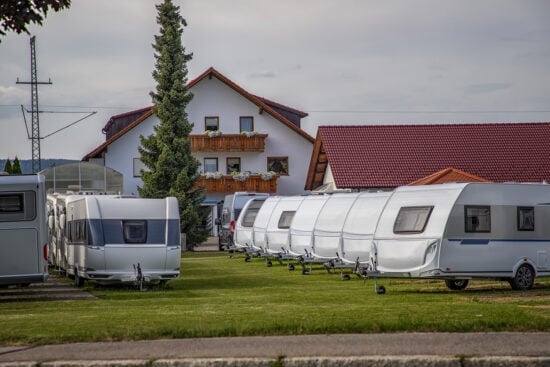Everyone loves creating memories in their RV, camper, motorhome, or trailer! However, parking a recreational vehicle in your backyard isn’t always a great option. In fact, it’s often illegal.
Finding a suitable storage option for your RV can be a challenge. To find a storage option that fits your needs and budget, learn about the different types of RV storage (and their adjoining costs) and determine which storage amenities you need.
How Much Does It Cost to Store an RV?
Depending on the type of RV you own, it can cost anywhere between $100 to $250 per month to store your RV at traditional self storage facilities.
With Neighbor, you can find RV storage that’s significantly cheaper, ranging from $50 to $150 per month.
Ultimately, when it comes to the cost of storing an RV, the final price will depend on the type of storage. For more information on the monthly storage costs that you can expect (depending on the type), keep reading.
Average Monthly Price to Store an RV (By Size)
The size of your RV or camper will dictate the size of the space you need to store it. For example, a full sized Class A motorhome will require a larger space than a small pop-up camper, therefore you can expect to pay more to store a motorhome than a camper trailer. Costs can vary even further, depending on if you’re storing indoors vs outdoors, under a covering or not, and so on.
So, how much does it cost to store an RV by size? Consider the prices associated with each of these common RV sizes.
| Typical Length (in feet) | Best Storage Unit Size (in feet) | Average Monthly Cost | Average Monthly Cost with Neighbor | |
| Class A Motorhomes | 25′ – 45′ | 30′ and up | $180 and up | |
| Class B Campers and Vans | 17′ – 23′ | 25′ – 40′ | $185 and up | |
| Class C RVs | 20′ – 30′ | 25′ – 35′ | ||
| Pop-up Trailers | 8′ – 15′ | 15′ – 20′ | $90 – $180 | $50 – $100 |
| Fifth-Wheel Trailers | 22′ – 40′ | 30′ and up | $185 and up | |
| Travel Trailers | 10′ – 40′ | 15′ and up | $90 – $185+ | $50 – $110+ |
For more information on how much storage units cost by size, see our storage size guide.
RV Storage Cost Factors
RV types vary widely, as do their owners. This means there are many types of storage to choose from, and your storage needs may be different from those of your neighbor who owns an RV. Certain factors about your unique wants and the type of RV you own will determine your monthly storage. These are the most common factors that influence RV storage costs:
Factor #1: Location
Monthly storage rates can differ widely from state to state. They often vary by population and demand in a specific area. For instance, you may find that RV storage is more expensive in heavily populated areas, urban areas with limited parking, and areas near popular RV camping sites.
Factor #2: Size
RVs can vary from 8 feet for the shortest pop-up trailers to 45 feet for a large Class A motorhome. The storage space (and, therefore, the cost) will be vastly different for different RVs. It’s likely that finding storage options for a Class A motorhome will present more challenges, as well.
Factor #3: Type of Storage
Storing your RV indoors has plenty of benefits, but you can definitely expect to pay more for indoor storage. While finding an indoor unit for your pop-up trailer or camper van may not be very difficult, finding indoor storage for a large motorhome may be more of an issue in some areas.
Factor #4: Amenities
If you can afford the costs, you may be able to find storage for your RV in an indoor space with a variety of amenities to keep your vehicle in top shape. Temperature control may seem like a luxury to some, but some storage solutions include options for valet parking, battery charging, and sewage dumping, as well. If you’re on a budget (or you want to save all your money for on-the-road splurges), you may want to consider which amenities have the most value for their cost.
Types of RV Storage
Your RV is a valuable investment. Like your RV maintenance and winterization tasks, the way you store it will be a determining factor in how you maintain your camper’s condition and how long it lasts. Often, budget is a factor in the type of storage you choose. Still, it’s a good idea to learn about the different storage types available and their benefits and drawbacks. RV storage is typically divided into three categories with varied options.
Indoor RV Storage Options
How much does it cost to store an RV indoors? It really depends on the type of indoor storage you choose, the size of your RV, and your location. Indoor RV storage costs can vary between $50 and $450 a month. But you can expect to see a big difference between the cheapest and most expensive units.
Indoor storage options for RVs include:
Communal Garage Storage

This option provides you with protection from the outdoor elements. However, you will likely be parked alongside other RVs. Garage storage will likely be cheaper than a roll-up door unit.
But how much does RV storage in a communal garage cost? The average price is $125-$260/month and up.
Pros:
- Complete protection from UV rays and harsh weather
- Security
- It’s a communal area that other RV owners frequent (developing a sense of community amongst your fellow RVers).
Cons:
- Possibility of damage from passers-by or dirt, dust, and other debris
- While cheaper than a single unit, it could be costly.
Single Unit Storage

Depending on the size of your RV, you may be able to rent an enclosed storage space that only fits your RV.
Roll-up door units for campers are typically around 20 feet wide and 45 feet long, allowing space for most campers to fit. Note: If you own a smaller Class B RV or a pop-up camper, you may be able to find a more traditional self storage unit that isn’t technically designed for recreational vehicles—but is still a usable space.
How much does it cost to store an RV in single-unit storage? The average price is $150-$450/month and up where available.
Pros:
- The most complete protection available
- Security
- You’re the only one with access to your unit.
Cons:
- The most expensive type of RV storage
- Accessibility may be limited in some facilities.
- Possible height limitations
Outdoor RV Storage
How much does it cost to store your RV outdoors? Outdoor RV storage is typically less expensive than other types of storage and reasonably practical for some types of large RVs. The average monthly cost of storing your RV outdoors ranges between $30 and $100 each month, depending on your location, the type of storage, and the RV size.
Open Land Lots
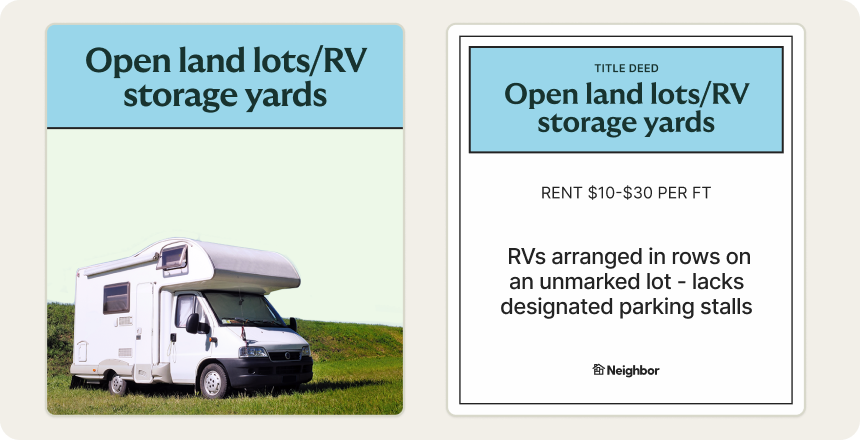
These are typically large dirt, paved, or gravel fields that provide space for RV owners to park wherever they choose. Open land lots may be fenced or not, and they offer little security.
How much does it cost to store an RV in an open lot? The average price is $55-$160.
Pros:
- Cheap cost
- Easy access
- Availability
Cons:
- Limited or no security
- Complete exposure to the elements
- Risk of vandalism or damage from other vehicles in the lot
Parking Spaces
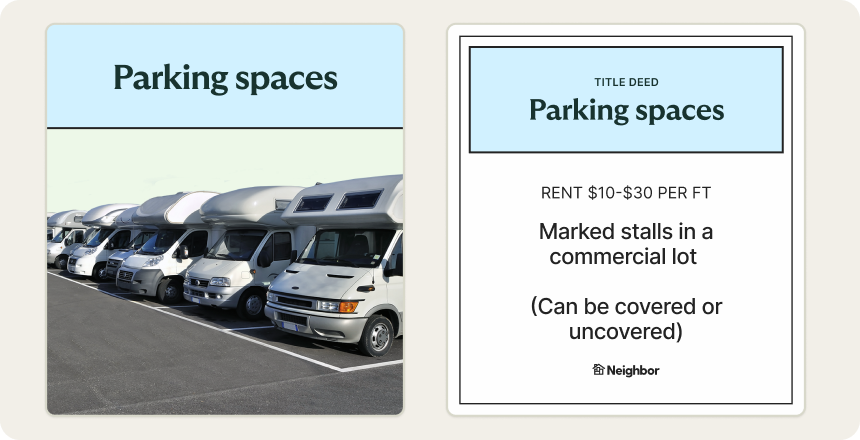
Large parking lots with designated spots are often available to fit most RVs. These lots are typically paved, may be fenced, and often have security cameras installed. Cost varies by space size.
Looking on average, how much does it cost to store an RV in a parking space? The average price is $75-$250.
Pros:
- Designated parking spots ensure you can keep your spot
- Potential security upgrade over open lots
- Affordability
Cons:
- Complete exposure to the elements
- Security is often limited.
Driveways

Driveway storage may be paved or unpaved, usually close to a building. This type of outdoor storage varies the most widely because it’s completely situational and based on the extra space that’s available. The cost may be cheaper than other alternatives, depending on your facility of choice & your location.
You can find driveways for rent in your area using Neighbor.
But, how much does storing an RV in a driveway cost? The average price varies widely by location and availability.
Pros:
- Affordable
- Possible security perks if you’re parked close to a building
- Possible protection against UV rays depending on your proximity to the building
Cons:
- Outdoor exposure
- HOA communities may prohibit parking an RV on a driveway
- Might not be possible for large motorhomes to fit
Covered RV storage
How much does storing an RV in a covered storage space cost? As you may have guessed, covered storage is a storage option that bridges the gap between indoor and outdoor storage—with the cost reflecting just that.
Covered RV storage typically ranges from $70 to $200 each month. On the cost spectrum, covered RV storage falls somewhere in the middle, right between indoor (high) and outdoor (low) storage costs.
Carports
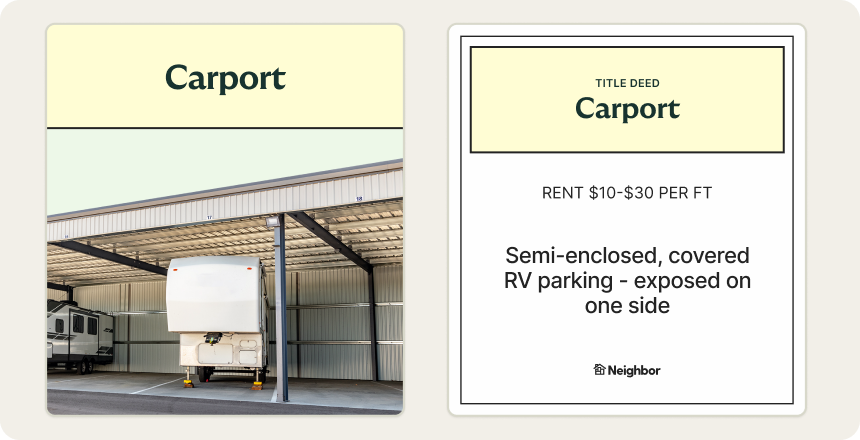
Despite leaving one side of the RV exposed, a carport still provides the protection of a roof, along with dual-side protection.
Some RV owners invest in a single carport to store their RV at home. However, many HOAs, neighborhood regulations, or apartment complexes won’t allow this option—the option sometimes referred to as covered, open-air storage.
If you don’t have the space to install a carport at home, you can find RV-friendly carports for rent in your own neighborhood with the help of Neighbor, an RV storage marketplace.
Pros:
- The most protective type of outdoor RV storage (protection from like rain, hail, snow, and ice)
- More affordable than indoor storage or other covered options
- Usually provides the height clearance needed.
Cons:
- Incomplete protection from the elements and UV rays
- More costly than a traditional parking space.
- Because it’s a communal storage option, high foot traffic can translate to a higher security risk.
Canopies
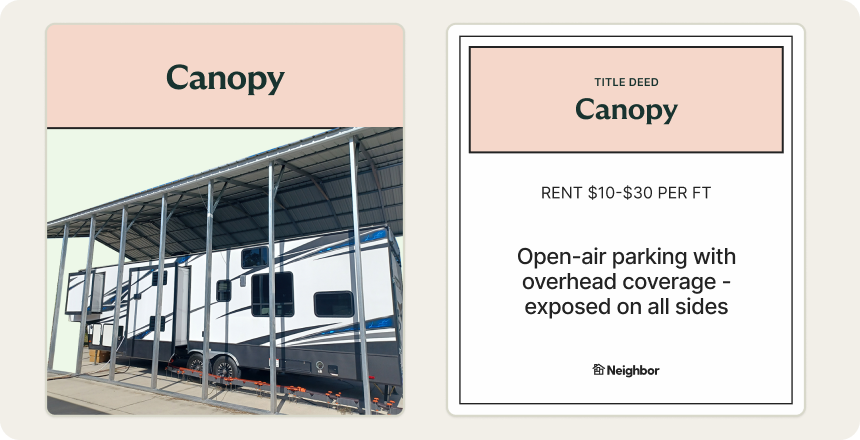
Unlike carports built with three walls for protection, a canopy leaves an RV exposed on either side. However, the roof installation can still safeguard an RV (at least partially) from harsh weather and UV rays. Choosing your parking space wisely can mitigate sun exposure, as well.
So, how much does it cost to store an RV in covered canopy storage? The average price is $60-$230.
Pros:
- Lower cost than indoor storage
- Can be installed at home
Cons:
- Exposes RV on two sides
- Safety level of this option is contingent on the parking location
Store Your RV with Neighbor
The cost of RV storage can vary widely depending on the size of your trailer and the storage type selected. Still, it’s an important part of owning an RV. The cost of storage may be a small price to pay if it means preventing more expensive costs, like repair costs due to weather-related damage, vandalism, or damage from flying debris.
Take some time to explore RV storage prices near you on Neighbor.
